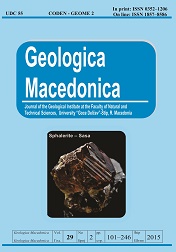Spatial distribution of chemical elements in soils in the Polog region, Republic of Macedonia
Abstract
The purpose of this study was to determine the presence and spatial distribution of various chemical elements in soil in the Polog region, Republic of Macedonia. For this purpose, geochemical monitoring techniques were applied for determination of 19 macro and trace elements (Al, B, Ba, Ca, Cd, Cr, Cu, Fe, K, Li, Mg, Mn, Na, Ni, P, Pb, Sr, V and Zn). A total of 116 soil samples (58 samples of topsoil and 58 samples of subsoil) were taken from predetermined referent locations. The collected samples were analyzed by the application of atomic emission spectrometry with inductively coupled plasma (ICP-AES). From the analyzed soil samples, 4 chemical associations were determined, from which three factors with lithogenic source (F1, F2 and F4) and one factor with mixed lithogenic and anthropogenic origin (F3). In factor 3 the anthropogenic impact is due to increased deposits of potassium in the surface soil layers in the southern parts of the Polog valley, where potassium fertilizers are used in agriculture. The elements which are included in the lithogenic factors are present in soil as a result of the geological structures in area where these elements are present (schists, carbonates, sandstones and sediments).Downloads
Download data is not yet available.
Downloads
Published
2015-12-11
Issue
Section
Articles
How to Cite
Spatial distribution of chemical elements in soils in the Polog region, Republic of Macedonia. (2015). Geologica Macedonica, 29(2), pp. 155-166. https://js.ugd.edu.mk/index.php/GEOLMAC/article/view/1225

